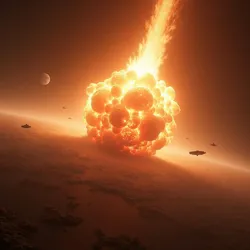Battle of Titan (2957)
 The devastating antimatter explosion that consumed Titan's Cassini Base during the battle's final hours
The devastating antimatter explosion that consumed Titan's Cassini Base during the battle's final hoursThe Battle of Titan was a major engagement during the Terran Civil War that took place on March 18, 2957, between forces loyal to Admiral Alexander Burton's Legitimist Forces and the Free Colonies Alliance. The battle resulted in catastrophic casualties on both sides and marked a significant escalation in the use of weapons of mass destruction during the civil war. The engagement ended in a pyrrhic victory for Free Colonies Alliance Vice Admiral Muhammad Amir, though the controversial mass executions that followed would later result in his prosecution at the War Crimes Tribunal.
Background
The Saturn system, particularly Titan with its valuable methane reserves and established colonial infrastructure, represented a crucial strategic asset in the early phase of the civil war. Titan's Cassini Industrial Complex supplied nearly 40% of the outer system's fusion fuel requirements, making it a prime military objective for Burton's Legitimist Forces who sought to strangle the Free Colonies Alliance's resource supply lines.
Rear Admiral Michelle Granger, commanding the Legitimist 4th Fleet, launched a surprise attack on Titan following months of covert intelligence gathering by Deep Space Reconnaissance Unit 7. Vice Admiral Muhammad Amir, who had recently secured Titan's allegiance to the Free Colonies Alliance through a combination of diplomatic pressure and military demonstrations, commanded the defense of the Saturnian moon.
Course of the Battle
Initial Engagement
The battle began at 0347 hours local time when Granger's fleet emerged from a high-velocity microjump near Titan's orbital plane. The Free Colonies Alliance defense grid, despite having only minimal warning, managed to engage the incoming Legitimist forces with a barrage of kinetic interceptors. Granger's fleet suffered early losses but succeeded in establishing a firing position above Titan's northern hemisphere.
Orbital Phase
The space battle quickly evolved into a complex three-dimensional engagement, with both sides employing advanced Neural Combat Systems to coordinate their forces. Granger's decision to deploy Relativistic Kill Vehicle platforms in Titan's upper atmosphere proved controversial, as several of these weapons impacted civilian areas when their targeting systems were compromised by electronic warfare.
The Mysterious Explosion
At 1523 hours, a massive explosion of unknown origin destroyed the Cassini Base's main reactor complex. While both sides initially blamed each other, later investigation by the Interstellar Reconstruction Authority suggested the involvement of a third party, possibly corporate saboteurs attempting to deny the facility to either side. The explosion rendered much of Titan's southern hemisphere uninhabitable for several months due to radioactive contamination.
Final Hours
In desperation, Granger authorized the use of antimatter weapons against Free Colonies Alliance positions, violating standing military protocols. The resulting chain reaction nearly destabilized Titan's atmosphere and caused the immediate death of over 50,000 civilians sheltering in underground facilities. This action prompted several ships in Granger's fleet to defect, ultimately leading to her defeat.
Aftermath
Mass Executions
Following his victory, Vice Admiral Amir ordered the systematic execution of captured Legitimist Forces personnel, claiming they had forfeited their rights to prisoner of war status by employing weapons of mass destruction against civilian targets. Over 3,000 prisoners were executed over a three-day period, including wounded personnel in medical facilities. These actions would later form the basis of Amir's indictment by the War Crimes Tribunal.
Strategic Impact
While the Free Colonies Alliance retained control of Titan, the battle's devastating impact on the moon's infrastructure effectively removed it as a strategic asset for the remainder of the war. The widespread use of antimatter weapons and relativistic kill vehicles during the battle led directly to the Richardson Protocols governing warfare in populated systems.
Legacy
The Battle of Titan stands as one of the most controversial engagements of the civil war, studied extensively at the Terran Military Academy as an example of how tactical decisions can have far-reaching strategic and ethical consequences. The battle's aftermath contributed significantly to the development of the Laws of Interstellar Combat, particularly regarding the use of weapons of mass destruction near civilian populations.
The site of the mass executions has been preserved as the Titan Memorial Complex, serving as a solemn reminder of the war's brutality. Annual ceremonies commemorate both the civilian casualties and the executed prisoners, though controversy continues over how to appropriately memorialize such a complex and tragic event.
See Also
- Terran Civil War
- Legitimist Forces
- Free Colonies Alliance
- War Crimes Tribunal
- Richardson Protocols
- Laws of Interstellar Combat
References
- Terran Union Federal Archives
- War Crimes Tribunal Proceedings
- Titan Memorial Complex Records
- Official History of the Terran Civil War